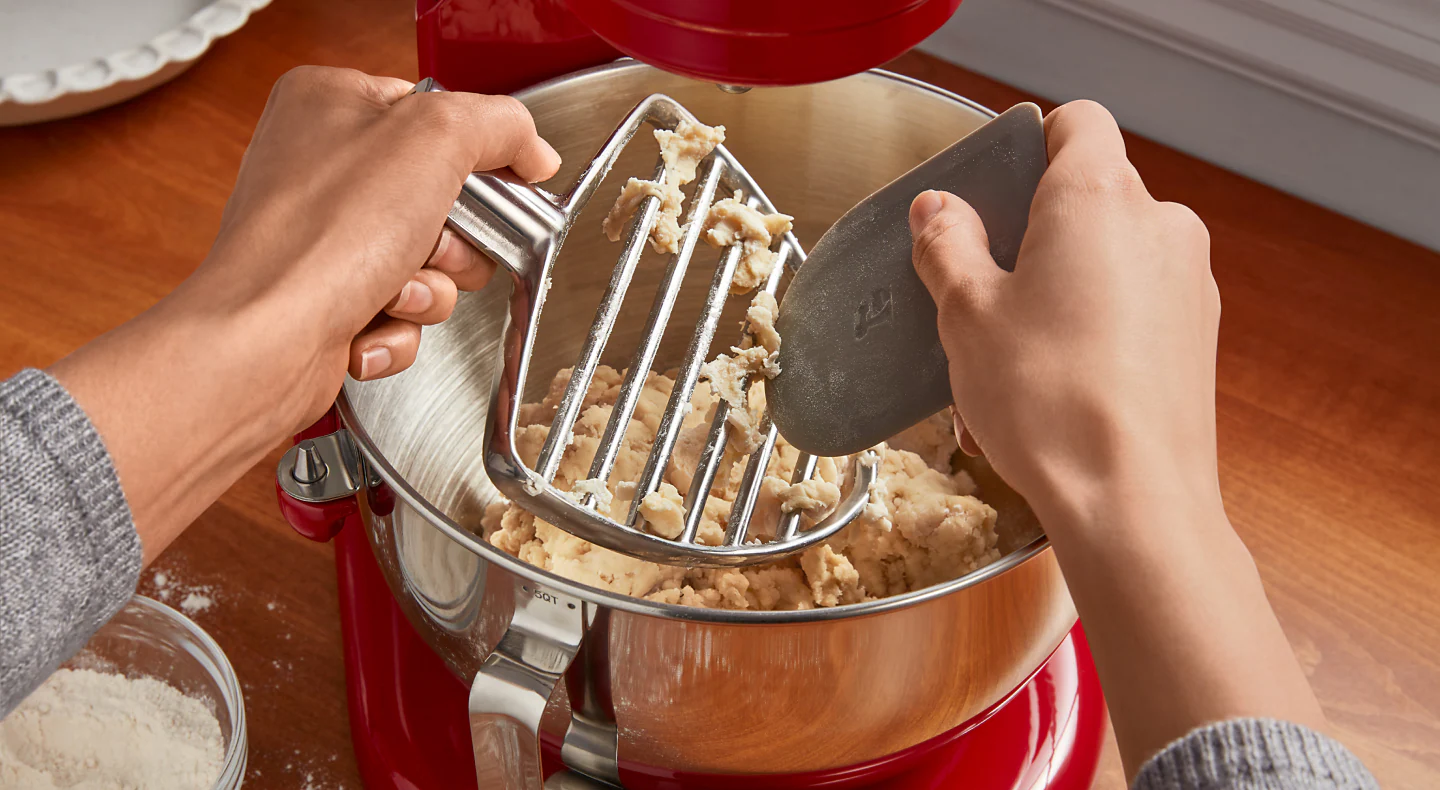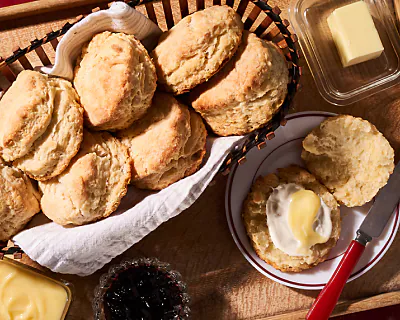Cutting butter into flour is an essential technique for flaky pastries and baked confections of all kinds. Explore the tools, tips and tricks you’ll need to master this task for delicious, buttery pie crusts, scones, tarts, empanadas and more. Learn about different ways to cut-in butter from the traditional pastry cutter to the all-new KitchenAid® Pastry Beater that helps you master this key technique with less effort.
How to cut butter into flour
How to cut butter into flour
What does it mean to cut in butter?
Cutting in butter is the process of breaking cold butter into smaller and smaller chunks while coating the pieces of butter with dry ingredients like flour. Unlike mixing or creaming, which fully incorporates the butter, this method leaves small pieces of butter intact before baking. Cutting butter into flour or other dry ingredients is an essential part of preparing pastry dough, biscuits and crumbly pie toppings because it gives a light and flaky texture that can’t be replicated with any other technique.

Why do I need to cut in my butter?
The little bits of butter in your mixture release steam as they melt which expands to create pockets of air and fat throughout the dough. Once the butter fully melts, the tiny pockets left behind create separation between the layers of baked dough. This is what gives pastry its delicate, flaky texture and rich buttery finish.

Methods for cutting butter into flour
Traditionally, this is a task done by hand using a knife or a pastry cutter. You can also use a food processor on a pulse setting to speed things along. To cut butter into flour with less effort and easy cleanup, you can also use the KitchenAid® Pastry Beater that attaches to your stand mixer.
Whichever method you use, it is important to work quickly to keep the butter from getting too soft. If the butter comes to room temperature it forms a paste with the flour which results in a dense and oily pastry.
Cutting in butter with knives
When using knives to cut butter into flour, you’ll literally cut the butter over and over again until you’re left with very small pieces of butter coated in flour. Take a knife in each hand and cut from the center, pulling out toward the edges of the bowl. This method can be done with tools you likely already have in your kitchen but can be a bit time-consuming and labor intensive.
Cutting in butter with a pastry cutter
Known as either a pastry cutter or blender, this specialized handheld tool features a series of metal strips or wires looped around and connected to a handle. When learning how to use a pastry cutter for butter, it may take some time to perfect your technique. Press the pastry blender down into the butter, twist and pull back up. Do this again and again until you get the right size chunks of butter per your recipe. This method is faster than using a knife but still requires a little muscle and practice.
You may feel that you need to stop a few times to clean the tines of the pastry cutter, which can make this method a bit time consuming as well. Again, speed is important to keep the butter cold before baking.

Cutting in butter with a food processor
You can also cut butter into your ingredients with a food processor. Just add ingredients to the work bowl and pulse in short bursts. Avoid over processing by sticking with the pulse function when using your food processor to cut butter into flour. This method also works well when cutting butter into sugar, oats and more for crumb toppings in recipes like 3 Berry Crumble bars or Dutch Apple Pie.
You can choose a food processor size to fit your recipes ranging from 3.5 Cup Food Choppers for small tasks all the way up to 13 Cup Food Processors from KitchenAid brand to take on multiple servings at once. Shop all KitchenAid® food processors to find the right size for your pastry recipes.

Cutting in butter with a pastry beater
An excellent substitute for a handheld pastry cutter or blender is the new KitchenAid® Pastry Beater accessory for your KitchenAid® stand mixer1. The pastry beater can be purchased separately for your existing mixer, or as part of a bundle with a new stand mixer. It is specifically designed for the challenging task of cutting cold butter into doughs for light and flaky pastries, such as puff pastries. The accessory works seamlessly with the bowl to break cold butter into small pieces, creating a consistent texture and even distribution, minimizing the risk of overmixing. Best of all, you can get handmade-quality pastry dough, with less effort. If you’re new to making homemade pastry recipes, the beater accessory is your gateway to the wide (and delicious) world of sweet and savory pastry creations.
In addition to cutting cold butter, you can also quickly shred meats, mash fruits, vegetables and other ingredients. This kind of versatility helps you create entire meals without ever changing the beater. Try making pulled pork hand pies using the accessory to both cut-in butter for the pastry dough and pull meat for the filling. Need an appetizer to go with it? Quickly mash up avocados for fresh guacamole without changing the accessory. The pastry beater can also mash potatoes, crush cooked apples for homemade applesauce or create chunky jams to top your homemade biscuits.
1. Sold separately

Explore KitchenAid® pastry beater accessories
Make pastry dough with confidence when you use the KitchenAid® Pastry Beater. Handmade-quality results with less effort are now possible with this accessory for your versatile KitchenAid® stand mixer1. Simply attach the pastry beater accessory, secure your bowl and you're ready to mix, cut, shred, mash and more. Available for select KitchenAid® tilt-Head2 and bowl-lift stand mixers3.
1. Sold separately 2. Fits all 4.5 and 5 quart KitchenAid® tilt-head stand mixers 3. Does not fit models KG25, 5KPM5, 5K5, 4KSM5, K5SS, KSM5, KSM50, KSM500, 3KSM5, 9KSM5 and KSM450
Tips for cutting butter into flour
1. Use cold butter
The bits of butter should be solid when you begin to bake the pastry dough. Since the butter will likely warm up a little as you work with it, starting with very cold butter stops it from completely melting into the flour mixture.
2. Leave room in the bowl
Make sure you only fill your bowl up to ⅔ full. The ingredients will need room to move around as you cut in the butter.
3. Check progress
The ideal size of your butter pieces will depend on the recipe. Make sure you know what you’re looking for before you get started and watch closely if using a food processor or stand mixer to avoid overmixing. If your recipe doesn’t specify, go with pea-sized.
Recipes that use the cutting in butter technique
Cutting butter into flour is most commonly used for pastry doughs like pie crusts, turnovers, quiche and more. But this technique also helps create buttery tart crusts, rich scones, crumble dessert layers and fruit crisp toppings. Get started with these recipes that cut butter into flour for tempting dishes that will have you coming back for seconds. Here’s an easy cream cheese frosting recipe or a buttercream frosting recipe for your cakes, pastries and sweets.
Everyday flaky biscuits

Pull apart the tender, fluffy layers of these classic biscuits for an indulgent breakfast or the perfect compliment to any meal. Smother them with homemade jam mashed with the KitchenAid® Pastry Beater or a zesty pomelo lime curd. For a savory take, serve them up with some homemade breakfast sausage and gravy.
Beef and cheese empanadas

Smoked paprika and monterey jack cheese set these empanadas apart and make it impossible to have just one. Poblano peppers add just a hint of heat that you can amplify with your own favorite additions to make this savory pastry dish your own.
Sweet cheese tarts

Mascarpone, Parmesan and cream cheeses come together with powdered sugar, vanilla and lemon juice to create a memorable dessert. Nestled in buttery tart pastry cups, this bite-sized confection is perfect to share at gatherings or to end dinner on a sweet note.
Savory mushroom galette

Flaky golden pastry and wild mushrooms share center stage in this complex yet earthy dish. Featuring Gruyère cheese and fresh thyme, these galettes bring the flavors of nature to your table.
Blueberry lattice pie
Elevate a classic favorite with a

lattice pie crust as beautiful as it is delicious. Orange zest adds brightness to the mellow sweetness of blueberries tempered with sugar. Or fill this pastry pie crust with your own favorite fruit fillings and flavor combinations.
KitchenAid Chef
— Sharing our passion for making
At KitchenAid, we unite people who love cooking and baking, brewing and creating. For over 100 years, KitchenAid has worked on behalf of every Maker out there. Our iconic tools are made with you in mind — opening the door to new possibilities and helping you to get most out of making.
